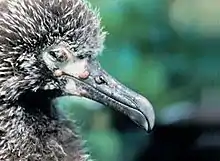Fowlpox
Fowlpox is the worldwide disease of poultry caused by viruses of the family Poxviridae and the genus Avipoxvirus. The viruses causing fowlpox are distinct from one another but antigenically similar, possible hosts including chickens, turkeys, quail, canaries, pigeons, and many other species of birds. There are two forms of the disease. The first is spread by biting insects (especially mosquitoes) and wound contamination and causes lesions on the comb, wattles, and beak. Birds affected by this form usually recover within a few weeks. The second form is spread by inhalation of the virus and causes a diphtheritic membrane to form in the mouth, pharynx, larynx, and sometimes the trachea. The prognosis for this form is poor.[1]
| Fowlpox virus | |
|---|---|
 | |
| Example of clinical signs produced by Fowlpox virus | |
| Virus classification | |
| (unranked): | Virus |
| Realm: | Varidnaviria |
| Kingdom: | Bamfordvirae |
| Phylum: | Nucleocytoviricota |
| Class: | Pokkesviricetes |
| Order: | Chitovirales |
| Family: | Poxviridae |
| Genus: | Avipoxvirus |
| Species: | Fowlpox virus |
Fowlpox in chickens
Fowlpox is a common disease in backyard chickens that have not been vaccinated. Most birds survive the infections, although very young or weak birds may be lost. The lesions initially looks like a whitish blister and appear on the comb, wattles and other skin areas. In rare cases lesions can be found on the body, legs and even sometimes the softer parts of the beak. The blisters develop into a dark scab and take about three weeks to heal and drop off. Fowlpox lesions, when in the infected birds mouth and throat can cause difficulty breathing, even death.[2] Scarring may result and consequently exhibition poultry breeders prefer to vaccinate and avoid this disease. Management of the mosquito population can help reduce outbreaks of fowlpox.
Treatment
Vaccines are available for fowlpox (ATCvet code: QI01AD12 (WHO)). Chicken are usually vaccinated with pigeonpox virus. This vaccine is usually given to chickens when between the age of 8-14 weeks of age, via the wing web method of injection. When a bird is given the vaccine they are exposed to a mild version of the active virus, so they should be completely healthy to prevent severe illness.[2] Turkeys are also routinely vaccinated.[3] Once a bird is infected there are no treatments, just preventive measures including the vaccine and mosquito management.[2]
References
- Fenner, Frank J.; Gibbs, E. Paul J.; Murphy, Frederick A.; Rott, Rudolph; Studdert, Michael J.; White, David O. (1993). Veterinary Virology (2nd ed.). Academic Press, Inc. ISBN 978-0-12-253056-2.
- Rossi, Gary D. Butcher and Fred (2015-06-19). "Prevention and Control of Fowl Pox in Backyard Chicken Flocks". edis.ifas.ufl.edu. Retrieved 2016-03-02.
- Carter, G.R.; Wise, D.J. (2006). "Poxviridae". A Concise Review of Veterinary Virology. Retrieved 2006-06-13.
External links
| Wikispecies has information related to Fowlpox. |
- Fowlpox at Backyard Poultry, Information and pictures.
- Species Profile - Fowlpox (Avipoxvirus), National Invasive Species Information Center, United States National Agricultural Library. Lists general information and resources for Fowlpox.
